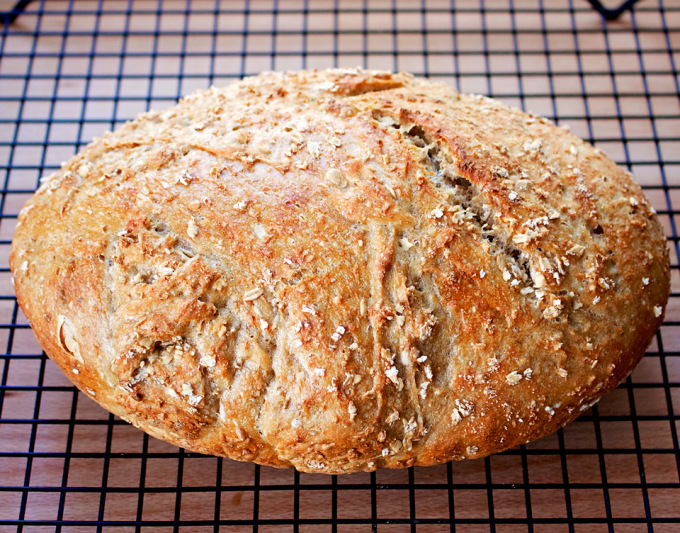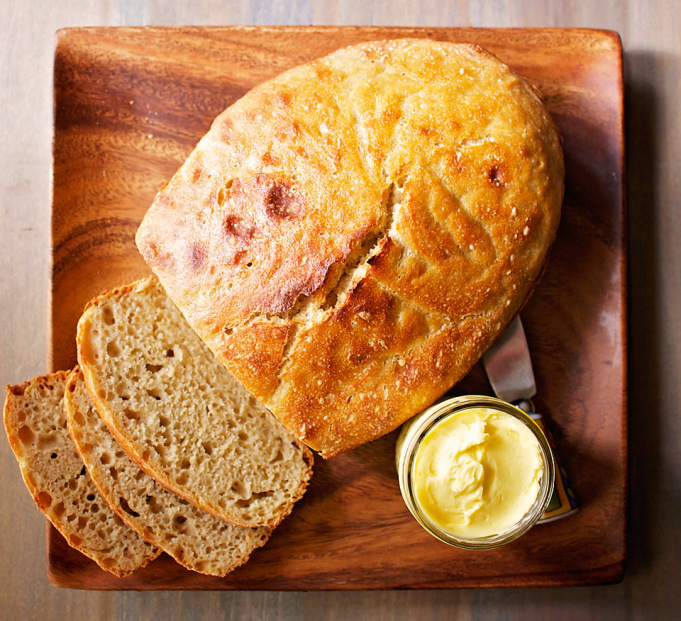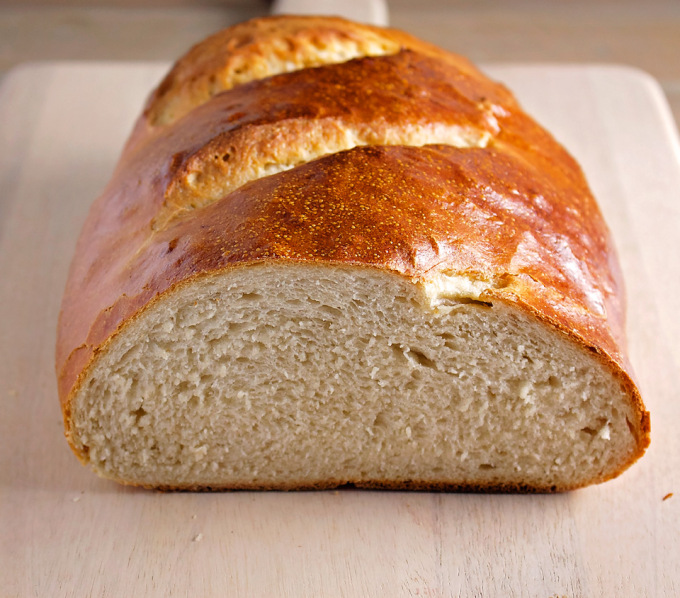Of Sourdough and Ancient Grains is about a baker who uses Einkorn, Spelt, and other ancient grains and leavens the bread with sourdough instead of yeast.
I’m captivated with ancient grains so whenever I learn about other bakers adding these grains to their repertoire, it motivates me to experiment more.
A few months ago, as I was scrolling through the feed of the Artisan Bread Bakers group on FB, I started seeing photos of breads being converted to Einkorn, Spelt, and other ancient grains and leavened with sourdough. I liked all of the breads, but the one that caught my eye was a Chocolate Marbled Sourdough Spelt Bread.

Chocolate Marbled Sourdough Spelt Bread, or Wassant bread – photo used with permission of Valeria of www.beetsandbones.com
I decided to find out more about the baker behind these breads and to share her story. The baker I’m referring to is Valeria of Beets and Bones. I hope her story and breads motivate you as much as they do me.
About the Baker…
Val describes herself as a mom cooking slow food in her fast world. She’s bringing back traditional recipes, and making new traditions.
Here is a little bit about her background.
Where are you from originally and how long have you been in the States?
I was born and raised in Russia, and came to the States 15 years ago. When I was growing up, whipping up a batch of dough was as normal as making a pot of coffee. Morning sweet rolls, savory dinner pies, you name it.. I remember being a very little tyke and being given the task of mixing ingredients and kneading. I was baking blini, Russian crepes, when I was 7. If you ever look at old school Russian recipes, they basically tell you to wing it, for example instead of giving the amount of flour needed for a recipe, you’d get – ‘enough flour to make a nice dough’.. no measurements.. seriously! I think that opened avenues for creativity and having more fun with ingredients than if somebody taught me to follow recipes.
How long have you been making bread and how did you get started?
When I was growing up, we used to bake a lot of yeasted breads, and even though my grandma uses a natural starter (‘zakvaska’) I never took much interest in it because my mom made fun of her calling it old-fashioned. I started naturally leavening my baked goods about three years ago when I decided that I need to go back to my grandma’s way of cooking, and ignore the sea of self conflicting information out there about what’s good for me.
What are your favorite types of bread to make and why?
My favorite bread to make is {my almost daily} simple sourdoughs with einkorn, oat and spelt flour. Every time I make them I try something different, like adding fermented or sprouted grains, TangZhong roux, different spices. I got to the point where I can make a great loaf without measuring, just tossing flours together until I get consistency I like. My oldest toddler made a drawing that had a big loaf of bread in the middle, and her family around it, and it just melted my heart.. I love it that my kids will have memories like the unforgettable aroma of baking bread at home and digging into a fresh hot crusty loaf.
Do you ever buy commercial bread?
All the bread we eat is homemade; not because I’m too good for store bought bread (not at all – there are some great bakeries in Chicago!), I just love baking, and it became such a second nature that it literally requires no effort.
Do you use any special flours or grains in your bread?
I prefer using ancient grains, like einkorn, spelt, kamut, rye and oat because I like the idea of eating something that hasn’t been hybridized. If a grain is modified to survive freezing temperatures, herbicides and insect infestation, what are the chances that our bodies can recognize it as real food?
Why did you start your blog? What types of information can visitors find on your blog?
To share my passion for real food, traditional recipes and techniques, and to learn along the way. My blog has information about fermenting, sprouting, some simple DIY, and all things naturally leavened.
—————————————————————
A few sourdoughs made with ancient grains:
Val has so many delightful breads that I couldn’t choose just one to showcase so I decided to feature a few of her loaves and include a description of each one. You can decide which loaf (or loaves) you like and visit her blog to view the recipe and instructions. Click on the name of the bread to go directly to the recipe.
Fermented Oat Sourdough with Spelt and Einkorn
The inspiration for this sourdough came from Chad Robertson’s Tartine #3 book. Almost all Tartine recipes call for at least some high-gluten modern wheat flours so Val simplified the process and changed it to incorporate only ancient grains. Also, based on the baking experience with ancient grains, which she says is starting to add up, she noticed that straying from the master’s recipe, and doing things her way is usually a good thing.

FERMENTED OAT SOURDOUGH WITH SPELT AND EINKORN – photo used with permission of Valeria of www.beetsandbones.com
Spelt Kamut Sourdough
Val came up with the recipe for this bread after baking countless loaves of sophisticated sourdoughs using the Tartine method. Every now and then, she would skip or modify a step and if she got a good result, she would continue to bake with her modifications. At the end, she settled on the process that she’s been using for quite some time with consistently great results. See for yourself.
She told me that she uses this recipe a lot with different grains. It’s easy because she just pours the dough into the Dutch oven and it works great. She’s actually been doing that a lot with all freshly milled einkorn berries and it works really well.

SPELT KAMUT SOURDOUGH – photo used with permission of Valeria of www.beetsandbones.com
Russian Sourdough Spelt Baton Bread
According to Val, there is not a single Russian who is not familiar with this bread, they all grew up eating it and loving it. It was the opposite of the dark rye bread, which was eaten along with meals; batons were served with tea, and smothered with jams and honey. Baton is slightly enriched (but not sweet, per se) white scored rounded loaf with fairly tight crumb and soft, slightly shiny crust. It’s normally made with commercial yeast and white bread flour, but her recipe uses all-purpose spelt flour, and is leavened naturally.

RUSSIAN SOURDOUGH SPELT BATON BREAD – photo used with permission of Valeria of www.beetsandbones.com
I want to thank Valeria for sharing her story and her breads with us. Please visit her blog Beets and Bones to find out more about her traditions and adventures in baking.
Happy Baking!
Cathy
Kathleen Cesarobe says
Ve just realized that regular wheat flour was hybridized by Monsanto. Not a good thing, in my opinion. I also trying to cut back on my carbohydrates, mostly in bread. I like the texture I get with regular flour,though. Is there any combination of ancien grain that could give me a lighter white bread?
I tried rye, Amaranth and regular gluten free flours, but the bread comes out heavy and dense. I’m not too fond of the grassy flavor coming from the Amaranth flour. Please help.
Thanks
Kathleen
Cathy says
If you are looking to incorporate ancient grains into your bread baking, and you are okay with using wheat flour, then spelt might be a good option. It’s one of the easiest ancient grains to work with. You can find all purpose and whole wheat spelt flour at many stores. I also enjoy working with einkorn and KAMUT, but you might find spelt easier to work with.